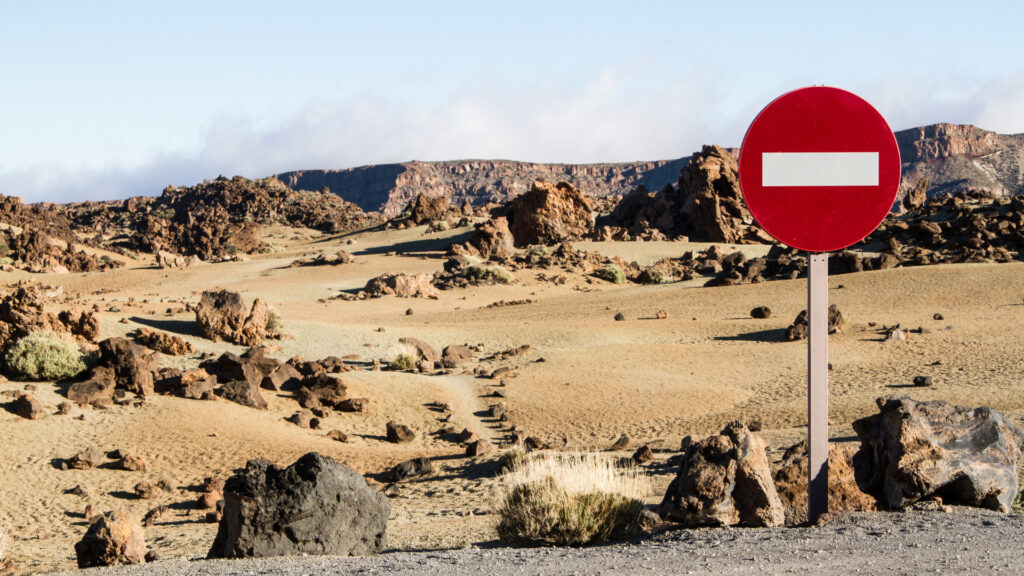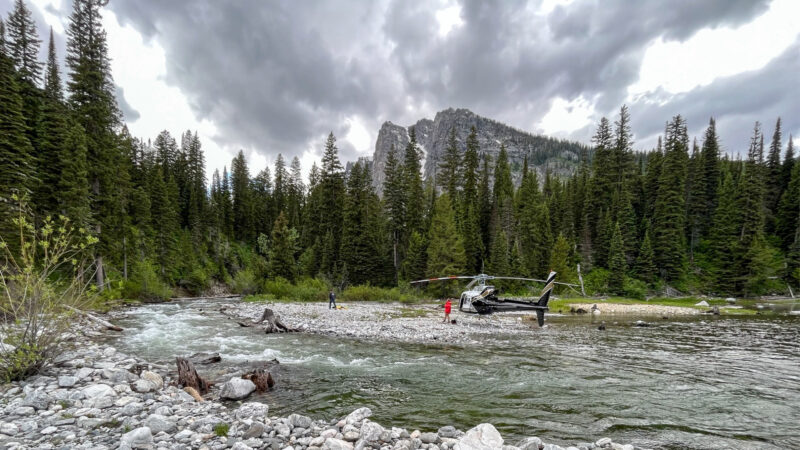Table of Contents Show
Some people have to make the same mistake multiple times before they learn their lesson. For one helicopter pilot, his mistake impacts his wallet and the national park.
National Park Service (NPS) officials take their rules and regulations seriously. They’re not afraid to sentence offenders to severe consequences, including fines and jail sentences.
Today, we’re sharing this pilot’s situation and other rules you want to follow while exploring national parks. Let’s get started!
Helicopter Lands in Grand Teton National Park
On June 24, 2023, Peter Smith, owner of West Elk Air, flew in a helicopter over Grand Teton National Park. Smith told the Associated Press that a passenger became ill and severe weather prohibited them from crossing the Tetons. Their only option was to find a safe place to land for the passenger to recover and to wait out the weather.
Unfortunately, the pilot allegedly chose to land near Moran Bay on the west shore of Jackson Lake. If you’re unaware, this is within Grand Teton National Park boundaries. Officials shared about the incident on their social media.
Their post reminded the public that laws prohibit unauthorized helicopter landings. They warned, “Each violation is a Class B misdemeanor that could include up to a $5,000 fine and/or six months in jail.”
It’s Not His First Violation
To make matters worse for Smith, the NPS mentioned it wasn’t his first violation. In February 2023, officials caught him flying below the minimum safe altitude over Curecanti National Recreation Area in Gunnison, Colorado. As a result of the incident, a federal judge fined him $530, which he paid.
With the judge seemingly being generous with him in February, we don’t expect he’ll experience the same luck. Having a similar offense occur so soon after the previous incident doesn’t look good.
He could potentially receive upward of $10,000 in fines. However, we’ll have to wait and see the consequences of Smith’s alleged actions and how the situation unfolds.
Are National Parks No Fly Zones?
National parks are not no-fly zones, but pilots must maintain an altitude of at least 2,000 feet above the ground and water. These regulations apply to lands managed by the NPS, U.S. Fish and Wildlife Service, and U.S. Forest Service Wilderness Areas.
Another frequent question regarding flying over public lands concerns drone pilots. Flying a drone in national parks has been illegal since 2014. This is mainly due to the concern of disturbing the wildlife and guest experience.
Can you imagine how many drones would buzz around climbers on Yosemite’s El Capitan and other landscapes? We’re thankful for this rule.
Other Rules You Want to Avoid Breaking in National Parks
You don’t have to be a pilot to understand that landing a helicopter in the middle of a national park is a bad idea.
However, there are some NPS rules that you need to know. If not, you could be on the receiving end of a stiff violation.
Feeding Wildlife
For some reason, many people find feeding the animals they encounter amusing. Unfortunately, human food can be harmful to animals. In addition, these actions can cause wildlife to become dependent on humans for food.
They’ll lose their desire to fend for themselves and instead rely on whatever they can get or steal. Additionally, it can cause health issues for the animal.
This can lead to dangerous encounters, especially for those visitors who follow the rules and don’t feed wildlife. An animal could become frustrated and act aggressively. The consequences of these violations aren’t something you want to take lightly.
While visitors can receive fines of up to $5,000 and six months in prison, it’s worse for wildlife. Officials often relocate animals in these situations away from the public, if possible. Any additional encounters with the animal and rangers will euthanize it. Do yourself and the animals a favor and keep your food to yourself.

Approaching Animals
NPS units are not zoos. Unfortunately, many visitors to public lands forget this simple concept. The animals you see roaming about in national parks are as wild as any animal can be. When you encounter one of these creatures, there’s nothing between you and them.
One of the most common mistakes visitors make has to do with bison. These massive animals are stronger and faster than they look. In addition, they often lack patience, especially with tourists who get too close. A bison can toss you 10 to 20 feet into the air in the blink of an eye.
Those who approach wildlife can receive fines of up to $5,000 and six months in prison. NPS regularly tracks down individuals in viral videos of these encounters. Again, we mean it when we tell you that NPS takes these violations extremely seriously.
Keep in Mind: You might be breaking this law every time you drive and could be putting others in danger. See what laws you might be breaking.
Littering
Many of us have learned the importance of cleaning up after ourselves. Unfortunately, not everyone can say the same. We’ve seen our fair share of trash on public lands. This is one of the primary reasons why some areas experience restrictions or temporary closures.
Littering anywhere is a serious offense, especially on public lands. The severity of the punishment depends on the situation. However, the minimum fine is $105, while the maximum is $5,000.
In addition, those convicted of the most severe offenses could face up to six months in prison. Consider these consequences before leaving your garbage behind.

Taking Artifacts
If you want to take something home to remember your trip, visit the gift shop. Taking rocks and other artifacts from federal lands is illegal. If caught, violators can receive severe fines and punishments. However, penalties and punishments may be the least of your worries.
Those visiting Hawaii Volcanoes National Park on the Big Island of Hawaii may want to think twice about swiping rocks. Local legend indicates that those who do are subject to the curse of Pele, the fire and volcano goddess.
Say what you want about legends, but the national park regularly receives packages from former guests returning rocks they’ve taken.
Ignoring Burn Bans
Some NPS units, especially out west, regularly experience fire restrictions. If you’re visiting these areas, you must obey the burn bans. When in effect, they’re not suggestions or recommendations; they’re the law.
Like many other severe violations, violators can face fines of up to $5,000 and several months of imprisonment. Ignoring burn bans puts you, other humans, and wildlife in danger. A fire doesn’t take much to get out of control, especially when everything around you is a potential fuel source.
Pro Tip: Not only do you not want to break these national park rules, but you don’t want to be rude by doing any of these 10 things in a national park!
Entering Restricted Areas
Officials create restricted areas for various reasons, one of which is to keep visitors safe. Don’t think you’re an exception to the rule if you come across a restricted area. They could be doing you a favor in trying to keep out of a dangerous area. Entering a confined space can come with severe punishments.
Because of the tremendous expense of rescuing hikers, some politicians want to push legislation for adventurers to bear some responsibility for these expenses.
States like Utah, with some of the most popular and dangerous national parks, often end up footing the bill. Considering some rescues cost well over $10,000, do you want that rescue bill? Probably not.

Not Acquiring Necessary Permits
Accessing some areas requires getting the proper permits. However, some places only require permits if you’re staying the night. The Grand Canyon is one great example.
Visitors don’t need to worry about a permit if they’re going on a day hike. However, it is a requirement for anyone looking to stay overnight in the canyon.
Some hikers think they can fly under the radar and camp in the canyon without getting caught. Thankfully, park officials frequently check permits to ensure everyone complies.
They’ll encourage those without access to leave the canyon and use radios to communicate with other staff members to ensure they do.
Getting caught without a permit typically results in a $250 fine per person. Don’t think about putting up a fight or trying to set up camp elsewhere along the trail. Doing so could turn your fine into $5,000 and require you to appear in court. Always make sure you acquire the proper permits.
Avoid Fines While Visiting National Park Units
Traveling can be expensive. However, those costs can climb quickly, especially if you receive fines during your adventures.
It doesn’t matter whether you’re exploring by helicopter or foot; know and follow the rules. Failing to do so can cost you a pretty penny. The more you pay in fines, the less you can spend on your next exciting expedition.
And we don’t just want you to avoid fines; we also want to protect the wildlife and nature of these protected resources and keep you safe from danger.






